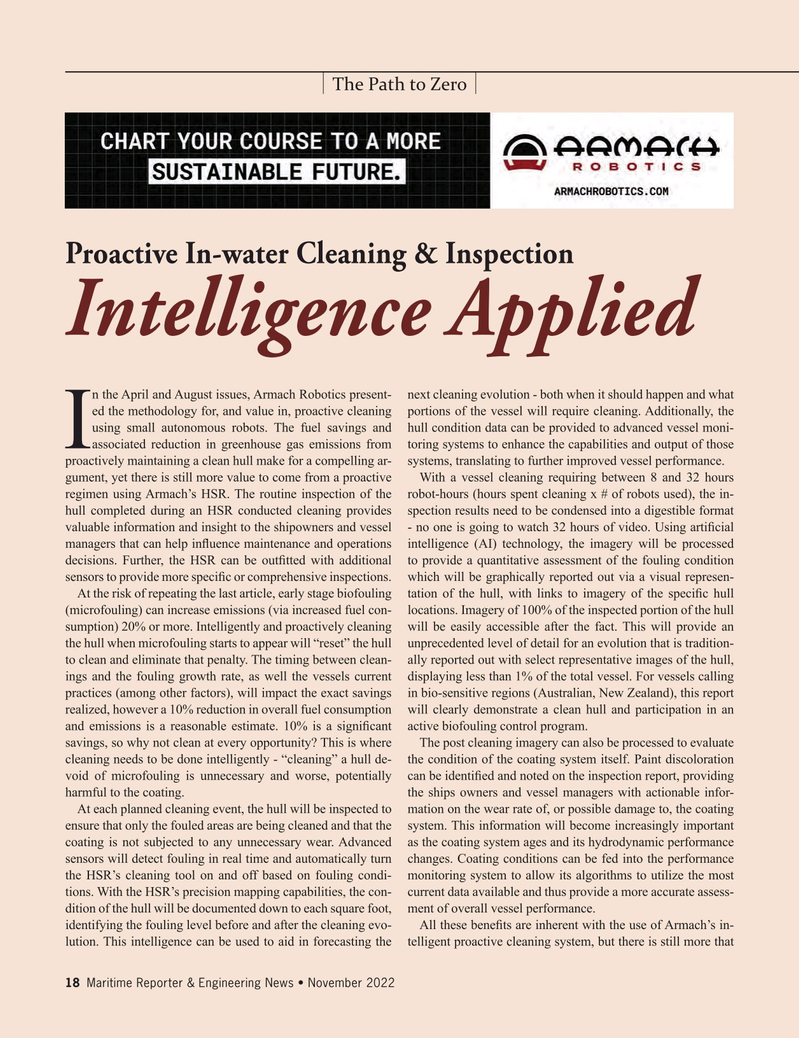
Page 18: of Maritime Reporter Magazine (November 2022)
The Workboat Edition
Read this page in Pdf, Flash or Html5 edition of November 2022 Maritime Reporter Magazine
The Path to Zero
Proactive In-water Cleaning & Inspection
Intelligence Applied n the April and August issues, Armach Robotics present- next cleaning evolution - both when it should happen and what ed the methodology for, and value in, proactive cleaning portions of the vessel will require cleaning. Additionally, the using small autonomous robots. The fuel savings and hull condition data can be provided to advanced vessel moni- associated reduction in greenhouse gas emissions from toring systems to enhance the capabilities and output of those
I proactively maintaining a clean hull make for a compelling ar- systems, translating to further improved vessel performance. gument, yet there is still more value to come from a proactive With a vessel cleaning requiring between 8 and 32 hours regimen using Armach’s HSR. The routine inspection of the robot-hours (hours spent cleaning x # of robots used), the in- hull completed during an HSR conducted cleaning provides spection results need to be condensed into a digestible format valuable information and insight to the shipowners and vessel - no one is going to watch 32 hours of video. Using arti? cial managers that can help in? uence maintenance and operations intelligence (AI) technology, the imagery will be processed decisions. Further, the HSR can be out? tted with additional to provide a quantitative assessment of the fouling condition sensors to provide more speci? c or comprehensive inspections. which will be graphically reported out via a visual represen-
At the risk of repeating the last article, early stage biofouling tation of the hull, with links to imagery of the speci? c hull (microfouling) can increase emissions (via increased fuel con- locations. Imagery of 100% of the inspected portion of the hull sumption) 20% or more. Intelligently and proactively cleaning will be easily accessible after the fact. This will provide an the hull when microfouling starts to appear will “reset” the hull unprecedented level of detail for an evolution that is tradition- to clean and eliminate that penalty. The timing between clean- ally reported out with select representative images of the hull, ings and the fouling growth rate, as well the vessels current displaying less than 1% of the total vessel. For vessels calling practices (among other factors), will impact the exact savings in bio-sensitive regions (Australian, New Zealand), this report realized, however a 10% reduction in overall fuel consumption will clearly demonstrate a clean hull and participation in an and emissions is a reasonable estimate. 10% is a signi? cant active biofouling control program. savings, so why not clean at every opportunity? This is where The post cleaning imagery can also be processed to evaluate cleaning needs to be done intelligently - “cleaning” a hull de- the condition of the coating system itself. Paint discoloration void of microfouling is unnecessary and worse, potentially can be identi? ed and noted on the inspection report, providing harmful to the coating. the ships owners and vessel managers with actionable infor-
At each planned cleaning event, the hull will be inspected to mation on the wear rate of, or possible damage to, the coating ensure that only the fouled areas are being cleaned and that the system. This information will become increasingly important coating is not subjected to any unnecessary wear. Advanced as the coating system ages and its hydrodynamic performance sensors will detect fouling in real time and automatically turn changes. Coating conditions can be fed into the performance the HSR’s cleaning tool on and off based on fouling condi- monitoring system to allow its algorithms to utilize the most tions. With the HSR’s precision mapping capabilities, the con- current data available and thus provide a more accurate assess- dition of the hull will be documented down to each square foot, ment of overall vessel performance. identifying the fouling level before and after the cleaning evo- All these bene? ts are inherent with the use of Armach’s in- lution. This intelligence can be used to aid in forecasting the telligent proactive cleaning system, but there is still more that 18 Maritime Reporter & Engineering News • November 2022
MR #11 (18-33).indd 18 11/3/2022 11:38:18 AM

 17
17

 19
19
